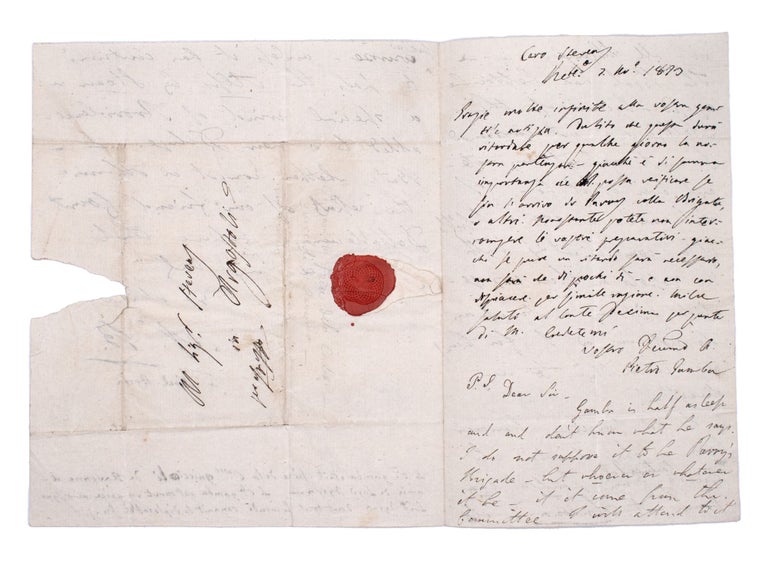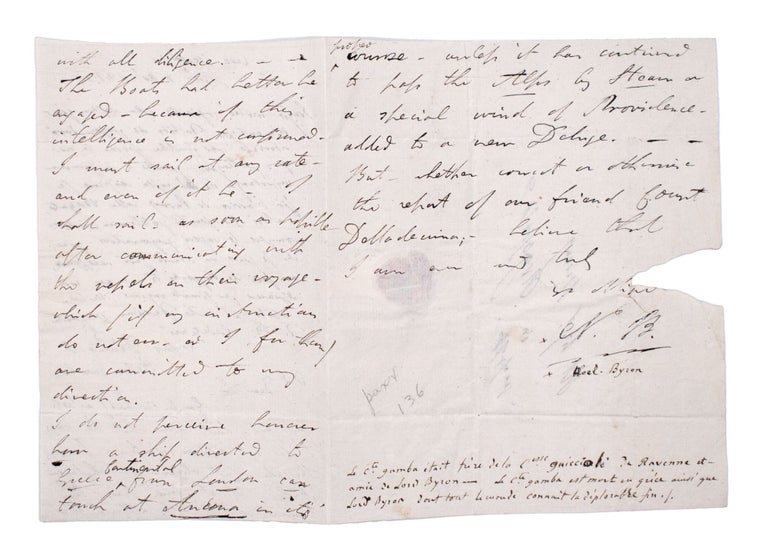‘I must sail … I shall sail’
Autograph letter, signed, with initials (“N. B.”), to George Stevens, written below a letter in Italian by Pietro Gamba.
[Cephalonia]: November 7, 1823.
Price: $30,000.00
About the item
3 pp. on a single sheet bifolium, with address To Msgr Stevens, Argostoli. 8vo. ‘I must sail … I shall sail’. Small tear above signature, from opening, wax seal still present. Old docketing in French. Marchand 10:161-2 (a partial transcription, misdated to May 1823).
Item #352339
A notable Byron letter, showing his commitment to join the armed struggle in Greece, just before he left Cephalonia for the Greek mainland. As is frequently the case, Byron writes beneath a letter from Count Gamba (whose sister was Byron’s mistress Countess Guiccioli), addressed “Caro Stevens”. The correspondent, George Stevens, was a customs official at Argostoli on Cephalonia and a recipient of several letters from Byron in 1823.
“P.S. Dear sir, Gamba is half asleep and and [sic] don't know what he says. I do not suppose it to be Parry's Brigade - but whoever or whatever it be - if it came from the committee I will attend to it with all diligence. The boats had better be engaged, because if this intelligence is not confirmed I must sail at any rate, and even if it be, I shall sail as soon as possible after communicating with the vessels on their voyage, which (if my instructions do not err, or I for them) are committed to my direction. I do not perceive however how a ship directed to Greece Continental from London can touch at Ancona in its propoer course, unless it has continued to pass the Alps by Steam or a special wind of Providence added to a new Deluge. But whether correct or otherwise the repeat of our friend Count Delladecima believe that I am ever and truly ...”
Byron had been staying on Cephalonia since August. Edward Trelawny, his opportunistic and self-aggrandizing sometime travelling companion, had gone to Greece in September and was soon converted to another faction in the Greek struggle for independence. In November, Byron was besieged by requests for money (and a week after this letter would pledge large sums to the cause). Here, he demonstrates a considerable flash of wit and knowledge of current technology, as he reminds his correspondent of the realities of Italian geography and suggests Steam power or a new Deluge as the only possible explanation for a proposed itinerary (Ancona is on the Adriatic far to the north of Cephalonia).
As the representative of the London Greek Committee, “Byron remained in Cephalonia with Pietro Gamba multiplying his Greek contacts and assessing information he was gathering as a prelude to action. When Prince Alexander Mavrocordatos, who eventually became first president of independent Greece, moved to Missolonghi in December he invited Byron to join him and his forces” (ODNB). Byron and Gamba departed from Argostoli on 29 December 1823. Gamba’s vessel was captured and briefly held by the Turks; Byron reached Missolonghion 4 January 1824.
This letter was previously known only in an excerpt from the description in catalogue 44 of F. Naylor, July 1878 (incorrectly dated to May and lacking the name of the correspondent), published in A Heart for Every Fate: Byron's Letters and Journals, Vol. 10 (1980), pp. 161-162.
A CHOICE BYRON LETTER FROM JUST BEFORE HIS FATEFUL EXPEDITION TO MISSOLONGHI.




